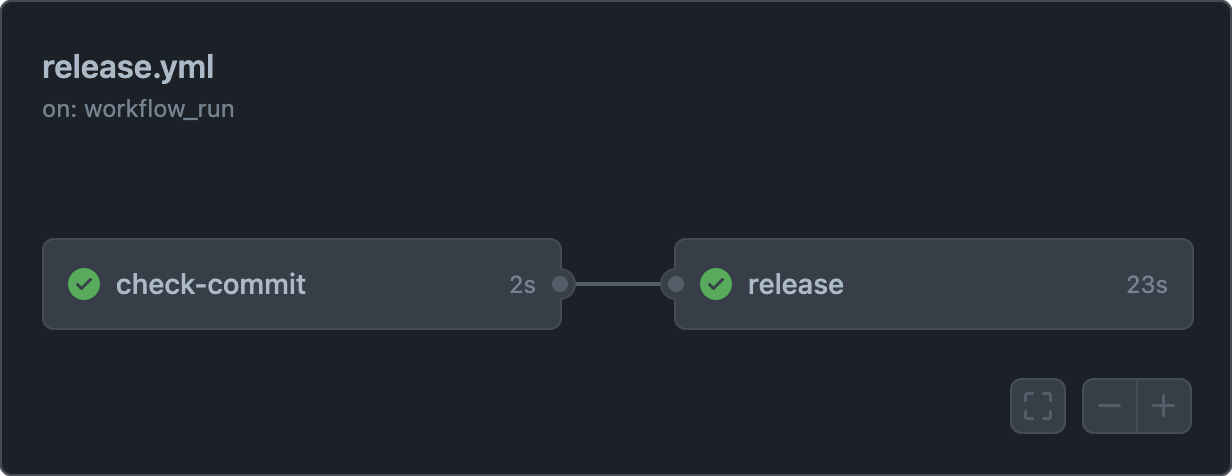Automated Release on GitHub Actions
There are many tools available to automate the release process for npm packages, such as lerna-lite for monorepos, Release It! for single packages etc. They can be used to automatically bump the version and generate changelog based on the commit messages using Conventional Commits, create a GitHub release, create a git tag, and publish the package to npm etc.
Generally, the release process is triggered manually by running a command on local machine. But automating the release process on GitHub Actions can be more convenient.
This guide documents how to configure GitHub Actions to automatically release npm packages on every commit using release-it. However, these steps can be adapted to other similar tools as well.
Step 1
Install release-it and @release-it/conventional-changelog as dev dependencies:
yarn add --dev release-it @release-it/conventional-changelogConfigure release-it in the package.json file:
{
...
"release-it": {
"git": {
"commitMessage": "chore: release ${version}",
"tagName": "v${version}"
},
"npm": {
"publish": true
},
"github": {
"release": true
},
"plugins": {
"@release-it/conventional-changelog": {
"preset": {
"name": "conventionalcommits"
},
"infile": "CHANGELOG.md"
}
}
},
...
}Step 2
Create a NPM token with publish access. You can create one at https://www.npmjs.com/settings/[username]/tokens (replace [username] with your username):
- Click on "Generate New Token" and select "Granular Access Token"
- Provide a token name and expiration date
- Under "Packages and scopes", select "Read and write" for permissions
- Then select "Only select packages and scopes" and select the package you want to publish
- Click "Generate token" and copy the token
Then the token needs to be added as a secret in the GitHub repository:
- Go to the repository and click on "Settings"
- Click on "Secrets and variables" and choose "Actions"
- Click "New repository secret" and add the token as
NPM_PUBLISH_TOKEN - Click on "Add secret" to save the token
This token will be used to authenticate with NPM to publish the package.
Step 3
Create a GitHub personal access token with the repo scope. You can create one under Developer settings in your profile settings.
Then the token needs to be added as a secret in the GitHub repository:
- Go to the repository and click on "Settings"
- Click on "Secrets and variables" and choose "Actions"
- Click "New repository secret" and add the token as
PERSONAL_ACCESS_TOKEN - Click on "Add secret" to save the token
A personal access token is necessary to be able to push the changes back to the repository if the release branch is protected. The user associated with the token needs to have admin access to the repository and be able to bypass branch protection rules.
Keep in mind that other collaborators on the repo can push actions that use this token and push commits acting as the user associated with the token.
If there are no branch protection rules in the repository, then the GITHUB_TOKEN secret can be used instead of a personal access token.
Step 4
Create a GitHub Actions workflow file in .github/workflows/release.yml with the following contents:
name: Release package
on:
workflow_run:
branches:
- main
workflows:
# List of workflows that runs tests, linting, etc.
# This ensures that the release is only triggered when the tests pass.
- CI
types:
- completed
jobs:
check-commit:
runs-on: ubuntu-latest
# Skip if the workflow run for tests, linting etc. is not successful
# Without this, the release will be triggered after the previous workflow run even if it failed.
if: ${{ github.event.workflow_run.conclusion == 'success' }}
outputs:
skip: ${{ steps.commit-message.outputs.skip }}
steps:
- name: Checkout
uses: actions/checkout@v3
# Check if the commit message is a release commit
# Without this, there will be an infinite loop of releases
- name: Get commit message
id: commit-message
run: |
MESSAGE=$(git log --format=%B -n 1 $(git log -1 --pretty=format:"%h"))
if [[ $MESSAGE == "chore: release "* ]]; then
echo "skip=true" >> $GITHUB_OUTPUT
fi
release:
runs-on: ubuntu-latest
needs: check-commit
# Skip if the commit message is a release commit
if: ${{ needs.check-commit.outputs.skip != 'true' }}
steps:
- name: Checkout
uses: actions/checkout@v3
with:
# This is needed to generate the changelog from commit messages
fetch-depth: 0
token: ${{ secrets.PERSONAL_ACCESS_TOKEN }}
- name: Setup Node.js
uses: actions/setup-node@v3
- name: Install dependencies
run: yarn install --immutable
shell: bash
- name: Configure Git
run: |
git config user.name "${GITHUB_ACTOR}"
git config user.email "${GITHUB_ACTOR}@users.noreply.github.com"
- name: Create release
run: |
npm config set //registry.npmjs.org/:_authToken $NPM_TOKEN
yarn release-it --ci
env:
GITHUB_TOKEN: ${{ secrets.PERSONAL_ACCESS_TOKEN }}
NPM_TOKEN: ${{ secrets.NPM_PUBLISH_TOKEN }}There are 2 important things to note in this workflow:
- The workflow runs on the
workflow_runevent. This event is triggered when another workflow is run. In this case, theCIworkflow is run on every commit to themainbranch. Thereleaseworkflow is triggered when theCIworkflow is completed. You may need to change the name according to the name of the workflow that runs tests, linting, etc. in your repository. - There are 2 jobs in the workflow. The first job checks if the commit message is a release commit. If it is, then the second job is skipped. This is to prevent an infinite loop of releases. The second job runs
release-itto publish the package.
After configuring, this workflow automatically publishes a new version of the package on every commit to the main branch after the CI workflow is successful.

Instead of publishing on every commit, an alternative way could be to have the release workflow configured, and run the workflow manually from the Actions tab in the repository when a new release is needed. This can be done by using the workflow_dispatch event to the on section:
name: Release package
on:
workflow_dispatch:
jobs:
release:
runs-on: ubuntu-latest
steps:
# Same steps as beforeSee the GitHub documentation for Manually running a workflow for more details.